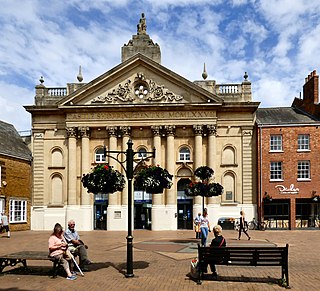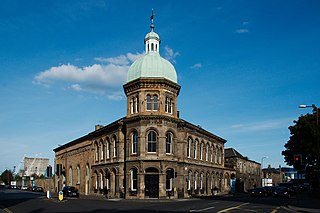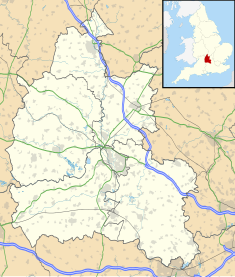
The Corn Exchange is an events and concert venue located on Wheeler Street in Cambridge, Cambridgeshire, England. The structure, which was commissioned as a corn exchange, is a Grade II listed building.

The Corn Exchange is a commercial building on The Payment in St Ives, Cambridgeshire, England. The structure, which is currently used as an events venue, is a Grade II listed building.

Corn exchanges are distinct buildings which were originally created as a venue for corn merchants to meet and arrange pricing with farmers for the sale of wheat, barley, and other corn crops. The word "corn" in British English denotes all cereal grains, such as wheat and barley. With the repeal of the Corn Laws in 1846, a large number of corn exchanges were built in England, particularly in the corn-growing areas of Eastern England.

The Corn Exchange is a commercial building in King Street, Ipswich, Suffolk, England. The structure, which is currently used as a public events venue, is Grade II listed building.

The Highland Council Headquarters, formerly County Buildings, is a municipal structure in Glenurquhart Road, Inverness, Highland, Scotland. The oldest part of the complex, which currently serves as the headquarters of The Highland Council, is a Category C listed building.

The Sessions House, also known as Sleaford Town Hall, is a judicial structure in the Market Place, Sleaford, Lincolnshire, England. The structure, which used to be the main courthouse for the county of Kesteven, is a Grade II* listed building.

The Corn Exchange is a commercial building on Fore Street in Hertford, Hertfordshire, England. The structure, which is currently used as an events venue, is a Grade II listed building.

The Cornhill Corn Exchange was a commercial building in the Market Place, Banbury, Oxfordshire, England. The façade of the building, which has been preserved and now forms an entrance to a shopping centre, is a Grade II listed building.

The Corn Exchange is a retail building in the Market Place, St Albans, Hertfordshire, England. The structure, which is now used to accommodate a pair of shops, is a locally listed building.

The Market House is a commercial building in Church Street in Camborne, Cornwall, England. The structure, which is currently used as a hotel and public house, is a Grade II listed building.

The Corn Exchange is a commercial building in the High Street, Dalkeith, Midlothian, Scotland. The structure, which is now used as a museum, is a Category A listed building.

The Corn Exchange is a commercial building in Withersfield Road in Haverhill, Suffolk, England. The structure, which is currently vacant and deteriorating, is a Grade II listed building.

The Corn Exchange is a commercial building in Woodmarket, Kelso, Scottish Borders, Scotland. The structure, which accommodates a health clinic, a dental practice and an online publisher, is a Category B listed building.

The Corn Exchange is a commercial building in Constitution Street, Leith, Scotland. The structure, which accommodates studio space and an exhibition gallery, is a Category A listed building.

The Corn Exchange is a commercial building in Market Street, Witney, Oxfordshire, England. The structure, which is used as a public events venue, is a Grade II listed building.

The Corn Exchange is a commercial building in the Market Place, Wallingford, Oxfordshire, England. The structure, which is used as a theatre, is a Grade II listed building.

The Corn Exchange is a commercial building in the Corn Market, Romsey, Hampshire, England. The structure, which is has been used extensively as a bank branch, is a Grade II* listed building.

The Corn Exchange is a commercial building in Sincil Street, Lincoln, Lincolnshire, England. The structure, which is now used as a restaurant and shops, is a Grade II listed building.

The Corn Exchange is a commercial building in the High Street in Ross-on-Wye, Herefordshire, England. The structure, which is now used as a bookshop and as the offices of Ross-on-Wye Town Council, is a Grade II listed building.

The Corn Exchange and Fire Station is a commercial complex in George Street in Oxford, Oxfordshire, England. The structure is now occupied by an arts charity, Arts at the Old Fire Station, and a homelessness charity, Crisis Skylight Oxford.





















